Software testing and quality assurance in software development are crucial.
Your business needs quality assurance for your software after investing in custom software development, which occurs in the software development life cycle (SDLC) testing phase.
Some of the worst software errors could’ve been avoided with higher software development standards, improved quality assurance and testing before launching the products or software solutions.
One of history’s worst software errors includes the story of NASA’s Mars Climate Orbiter blowing up in space in 1999 because software engineers failed to convert English to Russian units.
Let’s not forget about the virus that nearly started WW3 when an Iranian cyber attack shut down a nuclear plant in 2012!
Imagine how costly these mistakes were.
Improved software quality assurance during the testing stage may have prevented these incidents.
Let’s help you invest in quality software without risking NASA-sized losses.
Quality Assurance vs. Quality Control vs. Testing
Quality assurance (QA) ensures the final product is safe and functions as intended. Meanwhile, quality control (QC) defines management strategies to ensure quality assurance.
Finally, the testing stage detects and solves technical issues in a product’s source code. The chart shows how the three form part of QA management plan in software development:
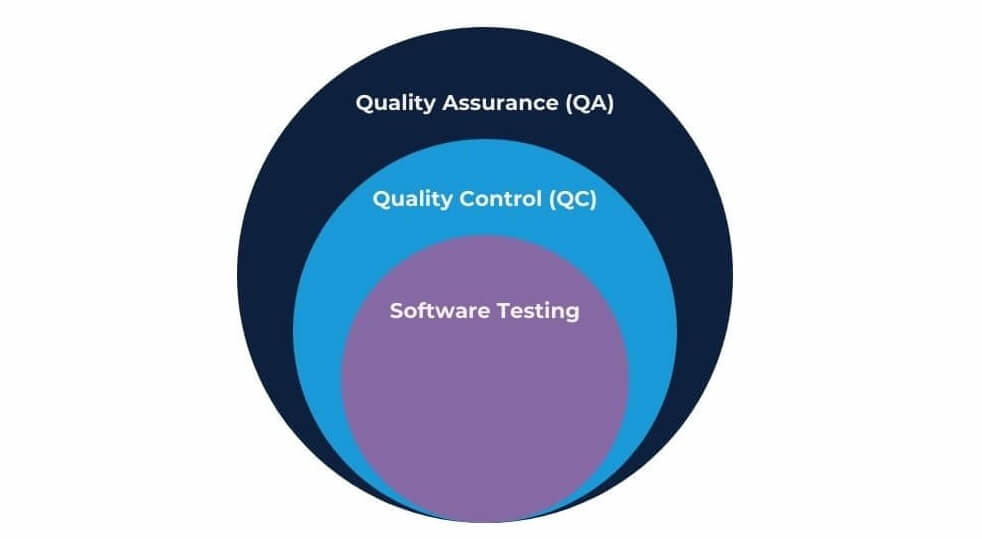
Also, the table shows a summary of the differences, which we’ll expand below.
| Aspect | Quality Assurance | Quality Control | Software Testing |
|---|---|---|---|
| Purpose | Prevent issues with established quality standards | Verify the product and requirements match | Identify and repair quality issues and defects |
| Who | QA engineers, business analysts, software developers | QA engineers and software developers | QA engineers and software developers |
| Focus | Development processes | Whole finished code | Different product aspects, like performance and security |
| When | Throughout the product development life cycle | Before the software’s release | During testing stages of the development process |
| Doing What | Introduce standards and outline product quality guidelines | Validate the product against the requirements | Review code, run tests, and address defects |
However, let’s dive deeper into the differences to ensure you can manage the QA plan and process with your QA team and other development teams.
What Is Quality Assurance (QA)?
Software quality assurance processes are consistent and continuous improvement strategies to guarantee the software product will meet user expectations and customer requirements.
Quality assurance is an organisational management strategy to improve the end-to-end product development lifecycle. It typically starts in the requirements analysis and lasts until maintenance.
Software quality assurance key activities include the following:
Set quality standards and procedures, including any that follow industry specifications
Create guidelines for the entire software development lifecycle (SDLC)
Measure solutions against technical threats
Review, change, and enhance workflows for the software processes
What Is Quality Control?
Software quality also relates to control. Quality control (QC) in software development is another part of quality management by verifying a system’s compliance with quality assurance standards.
Quality control is a systematic process the development team lead uses for assessing source code errors, vulnerabilities, threats, and defects to maintain the product’s quality standards.
Software engineering uses quality control to examine and adjust the end product quality, not to prepare management standards, guidelines, or procedures.
Other software quality control key activities include the following:
Evaluate the development team on quality-level skill sets
Impart training and certifications where necessary
Provide perfect customer services
What Is Software Testing?
Software development process testing is the final part of the procedural management phases in an SDLC. Testing is the primary technique used to detect and repair source code errors.
It follows the SQA management plan and must pass quality control, but testing tools play a role in the test stage. Test engineers or developers use test techniques during different SDLC phases.
Here are some QA testing methods test engineers use for continuous testing to examine and repair source code quality:
Functional testing
Integration testing
Load testing
Performance testing
Regression testing
Stress testing
System testing
Unit testing
User acceptance testing
The Complete Guide to Quality Assurance (QA)
Software quality assurance (SQA) is an entire management plan throughout the SDLC, but it heavily impacts the test process.
Understand more about the SQA management plan and testing execution to know what to expect and discuss the plan with the SQA team.
But first, software QA, test techniques, and control must follow quality assurance and software development best practices, which include:
Select careful release criteria
Create a robust testing environment
Apply automated tests to high-risk areas
Allocate enough time for each test phase
Prioritise defects based on software usage
Have a dedicated performance and security testing team
Simulate customer accounts similar to the production environment
Ensure the SQA best practices are a priority with your QA team, software development teams, and other teams. Furthermore, let’s discover the critical component list to ensure a good software investment.
Quality Assurance Specialists
A QA specialist is integral to software quality management, overseeing test cases, unit tests, automated testing, and usability tests throughout the entire development process.
A quality assurance specialist is anyone involved in QA activities, including engineers who write tests, project managers who outline a multi-testing strategy, and software testers who execute test cases.
Continuous delivery of high-quality control and assurance is the goal of any test environment or type. Here are some quality assurance specialists you may deal with throughout the entire process:
QA Automation Engineer – The automation engineering process requires someone with programming experience, who can write a test strategy or scripts for testing activities.
Software Development Engineer in Test (SDET) – Highly skilled engineers combine development, tests, and DevOps skills to automate test execution.
Software Test Engineer/QA Tester – QA testers primarily conduct manual testing activities, develop and execute test use cases, and document defects to report test results.
Test Analyst – An analyst focuses on business objectives, problems, and solutions instead of conducting technical reviews to ensure quality.
Test Architect – Senior software architects design complex test environments and infrastructures, identify QA process tech stacks and work with high-level test cases.
At Pulsion, we like to think of us as a quality assurance company. We guarantee a team of experts in various platforms, skills, and specialities. Read about us to see how our 30+ years of experience helped multiple well-known clients ensure quality in software.

Speak to one of our digital strategy consultants about your QA needs, or contact us to discuss QA.
Types of Software Quality Assurance (SQA)
Software developers and engineers use four types of quality assurance for software process improvement on existing processes and continuous integration of risk assessment.
Internal quality assurance refers to activity sets in an ongoing process within the engineering teams. Risk management assessments related to QA standards, procedures, and guidelines are a form of internal QA among the working team.
External quality assurance defines quality control measures, change management, and user interface testing by external sources. For example, usability test cases let users interact with the planned software to monitor user feedback and improvements in the app or web development cycle.
Process quality assurance refers to all processes and activities within the entire system and app development cycle. QA pros examine detected errors and implement the continuous deployment of security measures and test plans regarding the defined standards.
Product quality assurance describes software products entering the test design or test plan written by a QA specialist for ensuring quality in the final outcome. Different types must meet the acceptance criteria from the QA standards for the final product design.
Quality Assurance Tools and Certifications
Knowing the tools and certifications can help you select the right vendor. Choose a software vendor with certifications for standards quality processes, including the following:
Capability Maturity Model Integrated (CMMI) Level – Has levels 1-5 to indicate the maturity of the company’s quality assurance models.
ISO 9000 – Popular certification to show the vendor provides excellent customer satisfaction in procedural managing systems.
Test Maturity Model (TMM) – Has levels 1-5 to show the software partner’s QA managing models.
Also, different QA models, tools, and techniques exist. Here are some of the popular models used:
Process and Product Quality Assurance (PPQA) – Standards and protocols to solve QA issues.
Statistical Process Control (SPC) – Uses statistical tools to identify and correct QA problems.
Total Quality Management (TQM) – Designs a project-wide managing system for QA.
The Complete Guide to Software Testing
The testing level, test case, and risk mitigation strategies also play a crucial role in a creating high-quality product in the early stages and later stages of an SDLC with the highest standards. Let’s determine the relevant factors of the testing phase in quality assurance.
When Does Software Testing Happen in Different Software Development Life Cycle (SDLC) Models?
Quality assurance happens at different times in the software development life cycle model used. The software development process changes according to the methods applied.
Agile testing occurs in the Agile model. Agile methodologies go through planning, requirement engineering, documentation, design (prototyping), Agile development, testing, deployment, and maintenance phases in that order.
Testing occurs in multiple phases throughout the SDLC in Agile methodology. SQA ensures testing happens in design and prototyping, the testing stage, or during maintenance and support in the Agile software development lifecycle (SDLC).
QA experts use the Agile approach for short development cycles with exit criteria to satisfy customer needs. We use Agile at Pulsion!
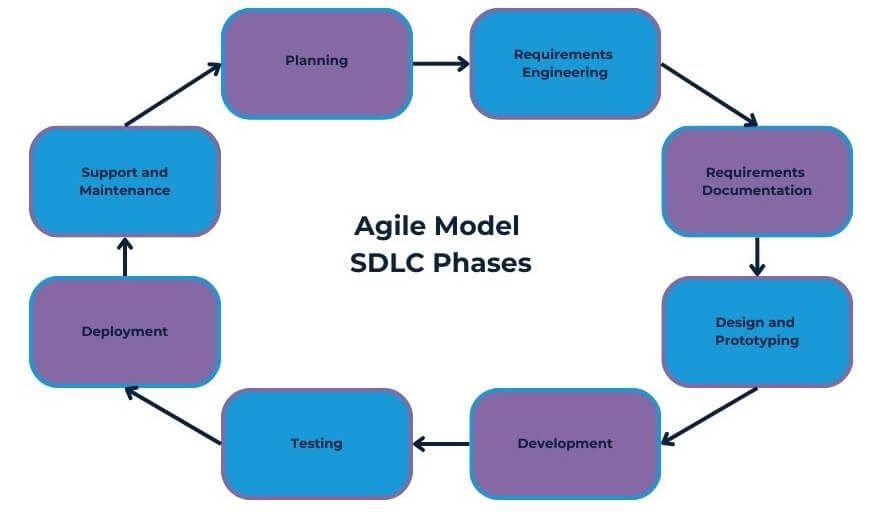
The Waterfall Model represents the most traditional SDLC. The phases include requirements gathering and requirements analysis, system design, development, testing, deployment, and maintenance in that order. QA testing process improvement occurs in the testing stage of the Waterfall Model.
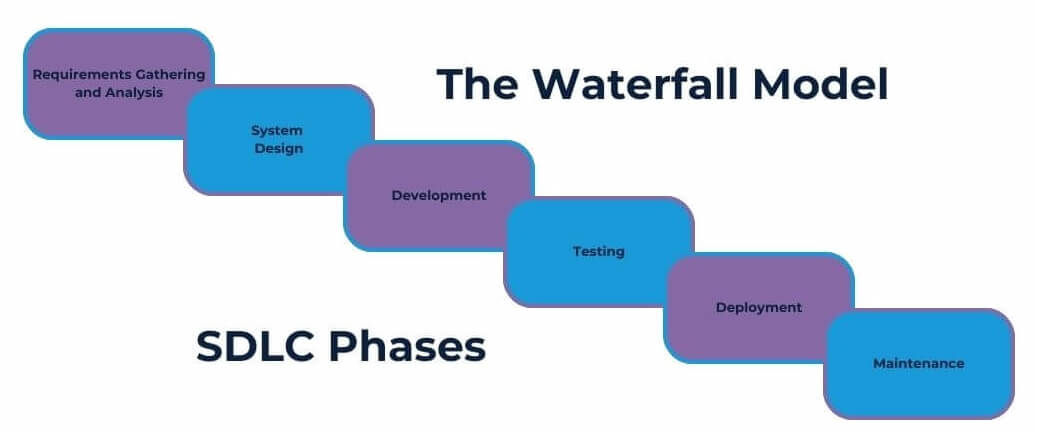
Finally, QA experts may use the DevOps model. DevOps testing follows the DevOps life cycle to analyse, develop, use continuous integration, deploy, operate, and gather continuous feedback.
QA occurs throughout DevOps. The model also uses a root-cause analysis in the requirement analysis phase to detect ripple defects before they reach end users. DevOps testing highlights brand reputation.
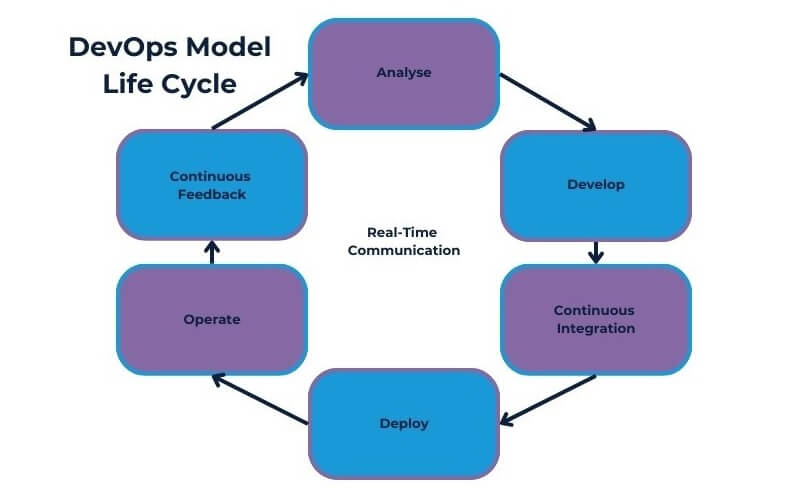
What Are the Software Testing Principles?
Let’s begin with the seven testing principles in QA management, which include the following:
The test must spot and reduce mistakes, defects, or errors.
Exhaustive testing mustn’t be possible under various scenarios.
Early testing must be available to prevent snowball faults and defects.
It must indicate the actual results of clustering defects in system modules.
It must apply a pesticide paradox to find new errors once detected errors are fixed.
It must use context-dependent testing processes to test various industries and brands.
The tests must not lead to an absence of errors fallacy as no code is perfectly error-free.
Also, frequent updates, new features, and generative AI open testing and SQA activities to trends. Some software design testing trends to gather high-quality specifications include the following:
Artificial Intelligence (AI) Testing – Artificial intelligence (AI) test automation using generative AI to identify more problems, measure change impact, and validate more efficient data scenarios.
Big Data – Big data testing assesses the quality of heavy data volumes and loads against characteristics, like conformity, duplication, consistency, validity, and completeness.
High-End Security Testing – Using network testing, system software security, client-side application security, and server-side application security test cases.
What Are the Software Testing Types, Levels, and Categories?
Furthermore, the QA testing software strategy types a vendor may practice cover essential functions, testing levels, various activities, tested specifications, and the critical production of high-quality products.
Furthermore, types of software testing strategy could lead to high-quality products. Here are different types of software testing strategies used by QA professionals to satisfy customers in different stages:
| Testing Strategy Type | Testing Category | Use Cases | Characteristics |
|---|---|---|---|
| Analytical Strategy | Preventive | Common and applicable to most projects | Originates from requirements or risk analysis |
| Consultative Strategy | Preventive and Reactive | User-centric scenarios | Customer or user feedback |
| Dynamic Strategy | Reactive | After deployment and during maintenance | Originates from running software defects |
| Methodical Strategy | Preventive | Typical applications and security testing stage | Originates from predefined standards and procedures |
| Model-Based Strategy | Preventive | Complex software systems | Originates from automated or generative testing |
| Regression-Averse Strategy | Preventive | Frequent updates to apps and web pages | Originates from changed software requirements |
| Standard-Compliant Strategy | Preventive | Highly-regulated industry apps, like the financial industry | Originates from industry standards and compliance rules |
QA engineers also satisfy customers and provide tested products without an exorbitant cost with different concepts and categories. For example, tests are static testing vs. dynamic testing.
Static testing, also called verification testing, examines the source code and related documents to ensure the code and documentation align. It detects problems early in the SDLC.
Dynamic testing occurs during test production to validate code behaviour. Dynamic testing is dynamic because it uses the use case testing type, acceptance testing level, and black box testing technique. The testing levels and types reveal how a dynamic multi-testing strategy works.
First, here are the levels of software testing for a quick comparison:
| Testing Level | Unit Testing | Integration Testing | System Testing | Acceptance Testing |
|---|---|---|---|---|
| Why | To ensure individual components behave as intended | To verify whether elements work together | Test product against functional/non-functional requirements | Check whether the product satisfies customer expectations |
| What | Isolated code parts | Interactions between code units and components | All the components as a whole | End-user requirements compliance |
| Who | Software developers | QA testers, test engineers, and software developers | QA team outside of the regular development team | QA engineer team and end users |
| Where | Development environment, testing environment, etc. | Testing environment and staging environment | Staging environment | Staging environment and production environment |
| When | During the development phase | When new components are added | When the software is integrated and complete | Right before the release at 90% complete |
| How | White box testing | Gray box testing and bottom-up, top-down testing | Black box testing | Black box testing |
| Automation Examples | Jasmine, NUnit, Jest, and JUnit | Citrus Framework, GitLab CI/CD, and FitNesse | Selenium, Katalon, and Cypress | Selenium, Watir, and Cucumber |
Meanwhile, here are the types of software testing compared:
| Testing Type Explained | Focus | Testing Level | Method Used |
|---|---|---|---|
| Performance Testing | Speed, responsiveness, and changing workload stability | All levels | White box testing and black box testing |
| Functional Testing | Product functionality | System level and user acceptance level | Blackbox testing |
| Usability Testing | User experience with the software product | Product development process (at the start of design) | Blackbox testing |
| Regression Testing | Product behaviour after changes or updates | Integration level and system level | White box testing and black box testing |
| Security Testing | Vulnerabilities, risks, threats, and weaknesses | All levels | White box, gray box, and black box testing |
How to Use Software Test Automation
Test automation helps reduce software development costs to customers. So, here are the phases of test automation the way our experts at Pulsion would design automated tests:
Complete a project analysis and risk analysis
Use framework engineering for improved development efficiency
Implement test case development and the relevant documentation
Implement test cases with a root cause analysis
Provide an iterative framework for continuous QA delivery
The 6 Software Testing Life Cycle (STLC) Phases
The testing process also has a life cycle. The software testing life cycle (STLC) has six phases. Here’s a breakdown of how the STLC phases work:
Testing Requirements Analysis Phase – Study test requirements and produce a requirement traceability matrix (RTM).
Software Test Planning Phase – Identify test scope and goals and select testing methodology to deliver the preferred test plans.
Test Case Development Phase – Create and review test cases, prepare the test data, and produce test cases with an updated RTM.
Test Environment Setup Phase – Configure the software, hardware, data, and networks to run tests to find bugs and defects, and deliver the testing environment.
Test Execution Phase – Execute tests to find bugs, report results, and produce execution reports, bug reports, and an updated RTM.
Test Closure Phase – Set test completion criteria, analyse results, and deliver a test summary with closure reports for all fixed bugs and defects.
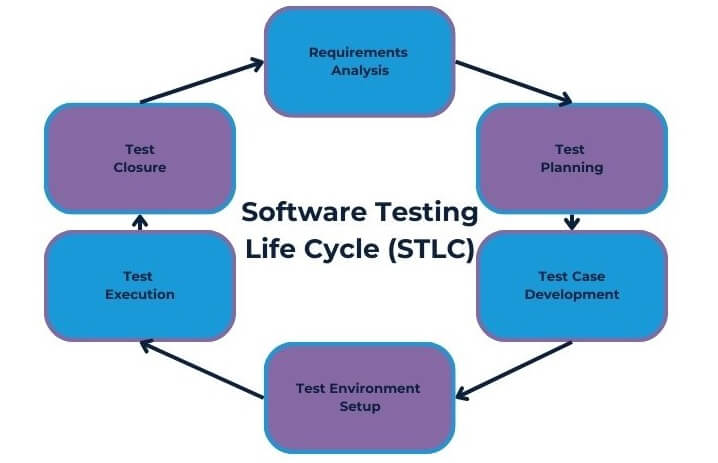
Summing Up Software Quality Assurance (QA)
QA, QC, and testing may feel complicated without the right team of experts on your side. You need a team to conduct tests, including load tests, regression testing, and white box testing, to mention a few.
Testers must prioritise testing quality on all levels, meeting all standards, and addressing industry best practices. Professionals also use the right tools, strategies, and types to ensure quality products.
We even have a tool called Requiment to help you with the first STLC phase: requirements analysis. Some of the benefits of using Requiment include a guided process and demo videos to help you.
Meanwhile, our Pulsion team is waiting to tackle your quality assurance standards and expectations. Contact us today to discuss your quality assurance and testing needs.
Software Quality Assurance FAQs
What Is Software Quality Assurance in Software Testing?
Quality assurance (QA) sets the guidelines, procedures, and standards for testing throughout software design. It’s an umbrella activity for testing, guiding the entire process to ensure you receive the ultimate software results. It outlines the preparation for all testing and quality control.
A QA ensures a high-quality software product delivery with a narrow focus on testing and standards. Your organisation receives an optimised software product to ensure it meets every expectation from experts who did the training in creating excellence and efficient results for all app or web stakeholders.
What Does a Software Quality Assurance Tester Do?
A QA testing expert implements the actual tests during the SDLC testing phases to locate and fix an error, perform audits of source code, and ensure conformance with the QA standards. Other issues these experts test include whether the software is stable and developer code standards.
Testers assess every part of the code, decide which subject to repair, and distinguish the difference between various risks. Reporting is another task testers provide to businesses and companies, whether software complexity is low or high. These audits are instrumental to establish successful results.
What Do Quality Assurance Engineers Do?
Reviewing the code can confirm whether the software meets the QA standards. However, engineers are also responsible for writing test cases, writing reports, setting the difference between test levels, and the measurement of requirements against documents in the program.
Businesses often rely on communication, which is a small part of professional engineering efficiency. Engineers address what they can in the program code once evaluated. Reporting will follow before product launch according to the International Organization for Standardisation (ISO).
What Is Quality Assurance in the Software Engineering Process?
Software engineering processes include a quality assurance phase in the software development lifecycle. Software engineering standards and best practices include quality assurance to give your business processes the ultimate software product.
Conducted tests and focuses on specific service issues developers may have missed could save your company money and time. Time-consuming software costs money. Ultimately, the product meets service industry standards to make an informed decision about your product.
Other stakeholders can have the same goal as you when QA helps save money and overcome tight deadlines in change requests and software development processes ad hoc. Meanwhile, the product will meet the Institute of Electrical and Engineering Standards Association (IEEE) standards for your industry.
Does Software QA Testing Improve Quality Standards?
High-quality software originates from quality assurance, testing, and proper quality management. QA will ensure a product works as intended scalability is part of the scope. QA can define compatibility, enhance productivity, and manage good relations in software-based work products.
Evaluating essential tasks and features of an app or webpage release in a competitive market is crucial to quality standards. Integration, manual testing, and a developed article focuses on quality standards in QA. Any company with developed software should have conducted QA testing.
Does Quality Assurance Require Coding?
Software product QA lists functional requirements, which testing examines to see if they align with the documents. These requirements become code, which testing examines in new processes. Coding is integral to verify the product or service meets the standards in an expected review.
The main objective of QA is to follow standards, but code is required to prevent cyber attacks and create processes. The processes may include a new feature, a focus on reliability, monitoring, functionality, reliability techniques, and expected monitoring tools and resources, which need coding.




